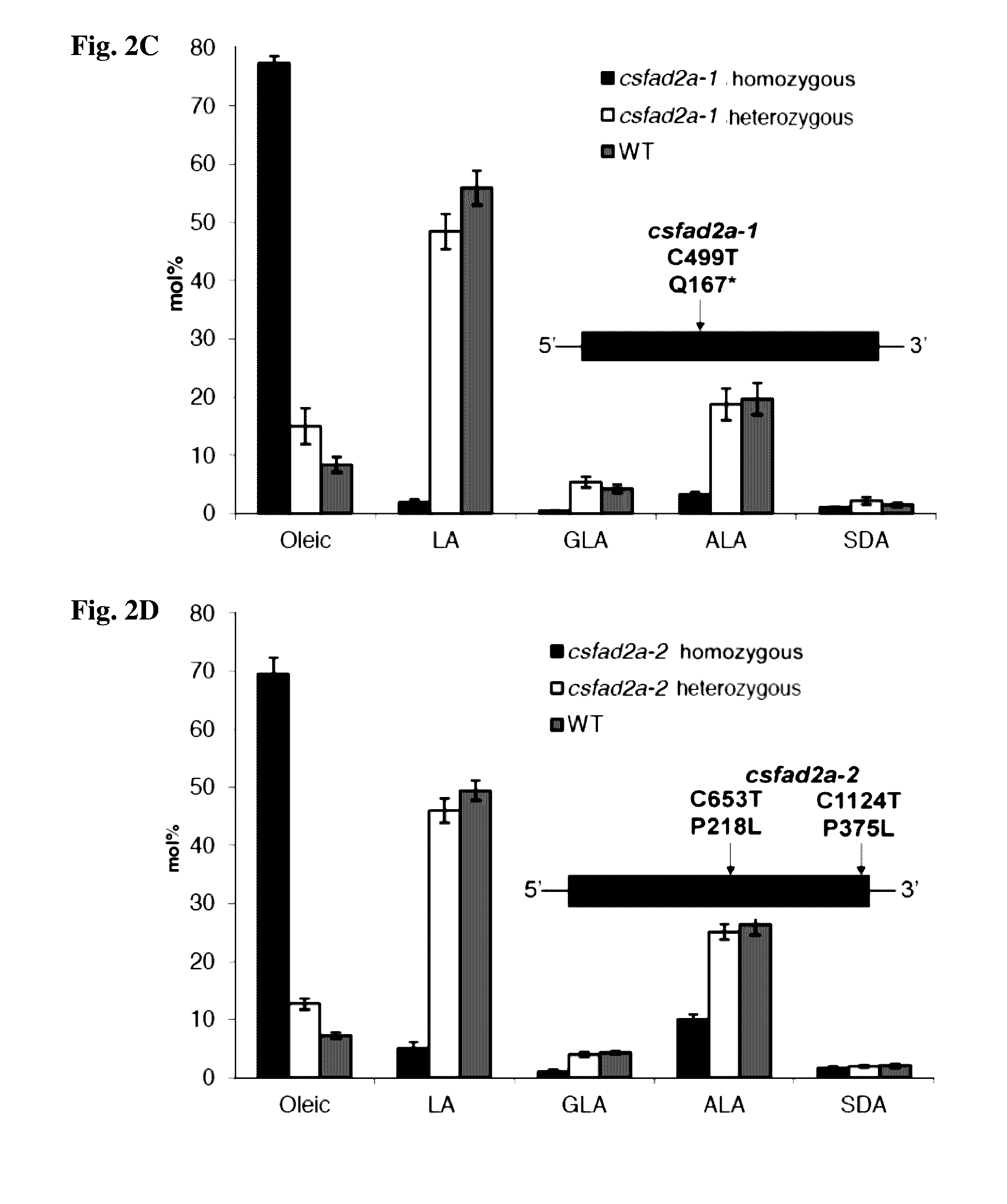Desaturase nucleic acids and polypeptides
a technology of applied in the field of desaturase nucleic acids and polypeptides, can solve the problems of polyunsaturated oils being considered contaminants in oils for industrial use, and achieve the effect of enhancing oleic acid content, reducing or abrogating expression or activity
- Summary
- Abstract
- Description
- Claims
- Application Information
AI Technical Summary
Benefits of technology
Problems solved by technology
Method used
Image
Examples
example 2
Deep Sequencing of the Developing Seed Transcriptome Identifies Candidate Desaturases Involved in Modifying Fatty Acid Composition of Seed Oil
[0182]EST libraries were prepared by deep sequencing cDNA prepared from RNA isolated from Torpedo (T), Upturned (U) and Filled Not Desiccated (FND) stages of Finola embryo development as depicted in FIG. 1A. Raw reads were mapped to the open reading frames of seventeen putative desaturase genes as detailed in Table 1. Three of the five plastidial stearoyl-ACP desaturases are expressed with CSSACPD-C transcripts being the most abundant, three of the seven CSFAD2 genes are expressed with CSFAD2A being the highest, all three of the CSFAD3 genes are expressed but of these only CSFAD3A increases during embryo development with CSFAD3B and CSFAD3C present at very low levels. CSD8 and CSD6 show similar low levels of expression up until the Upturned stage with transcripts of both genes being absent at the later FND stage (FIG. 1A). Based on homology an...
example 3
Identification and Characterization of Three CSFAD2A Desaturase Mutants
[0184]To establish the in-vivo role of CSFAD2A we screened an ethyl methane sulphonate (EMS) mutagenized M2 out-crossed population of Finola using the TILLING method (Till et al., 2006). We identified an allelic series of mutations among which csfad2a-1 carries a stop codon at amino acid position 167. We performed two rounds of backcrossing of csfad2a-1 to Finola and obtained homozygous csfad2a-1 individuals (BC2F1) by crossing heterozygous male and female BC2 siblings. csfad2a-1 homozygotes displayed a dramatic increase in oleic acid content to 77 molar % in seed oil (FIG. 2C; Table 2). In parallel, the levels of LA and ALA were strongly decreased compared to the fatty acid profile of the segregating wild type seed oil from the same population suggesting that this decrease was at the expense of the increase in oleic acid (FIG. 2C; Table 2). Two novel fatty acids appeared in csfad2a-1 at 5 and 2 molar percent (Ta...
example 4
Characterisation of the Cannabis sativa Microsomal Desaturase CSFAD3A
[0187]Quantitative RT-PCR confirmed expression of CSFAD3A in both leaves and embryos and showed it to be induced during seed development peaking at the FND stage where it is about 14 times higher than levels in young leaves (FIG. 3A). Heterologous expression of CSFAD3A in S. cerevisiae followed by fatty acid feeding resulted in desaturation of linoleic (18:2Δ9,12) to α-linolenic acid (18:3Δ9,12,15) and γ-linolenic acid (18:3Δ6,9,12) to stearidonic acid (18:4Δ6,9,12,15) at a conversion efficiency of 56% and 23%, respectively (FIG. 3B; Table 3). The yeast CSFAD3A transformants also exhibited low level activity with endogenous 16:1Δ9 and 18:1Δ9 resulting in what we identified as 16:2Δ9,15 and 18:2Δ9,15 respectively (Table 3, FIGS. 6A-6C and 7A-7D). CSFAD3A transformants did not show any activity on exogenously supplied 20:1Δ11 after 28 hrs incubation. Together these results confirm that CSFAD3A acts as a Δ15-desaturas...
PUM
| Property | Measurement | Unit |
|---|---|---|
| temperature | aaaaa | aaaaa |
| total volume | aaaaa | aaaaa |
| concentration | aaaaa | aaaaa |
Abstract
Description
Claims
Application Information
 Login to View More
Login to View More - R&D
- Intellectual Property
- Life Sciences
- Materials
- Tech Scout
- Unparalleled Data Quality
- Higher Quality Content
- 60% Fewer Hallucinations
Browse by: Latest US Patents, China's latest patents, Technical Efficacy Thesaurus, Application Domain, Technology Topic, Popular Technical Reports.
© 2025 PatSnap. All rights reserved.Legal|Privacy policy|Modern Slavery Act Transparency Statement|Sitemap|About US| Contact US: help@patsnap.com



